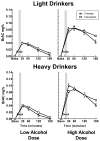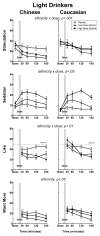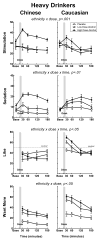Differences in subjective response to alcohol in heavy- and light-drinking Chinese men versus Caucasian American men
- PMID: 25203488
- PMCID: PMC4270853
- DOI: 10.1111/add.12737
Differences in subjective response to alcohol in heavy- and light-drinking Chinese men versus Caucasian American men
Abstract
Aims: To compare subjective responses to alcohol among Han Chinese and Caucasian American males.
Design: Double-blinded, placebo-controlled human laboratory design. Participants completed three randomized experimental sessions with high and low alcohol and placebo beverages.
Setting: Chinese participants were examined at Xinjiang Medical University, China. Caucasian participants were examined at the University of Chicago, USA.
Participants: Seventy Han Chinese (35 heavy/35 light drinkers) and 75 Caucasian Americans (43 heavy/32 light drinkers).
Measurements: Breath alcohol concentration (BrAC) and the 'stimulation' and 'sedation' subscales of the Biphasic Alcohol Effects Scale were assessed at pre-drink baseline and four time-points after beverage consumption. The 'like' and 'want' subscales of the Drug Effects Questionnaire were also assessed at the post-drink assessments.
Findings: Comparisons with light drinkers showed that high- and low-dose alcohol produced decreases in stimulation, liking and wanting in Chinese versus Caucasians (P < 0.05), and dose-dependent increases in sedation in both groups (P < 0.001). Among heavy drinkers, high-dose alcohol produced higher stimulation (P < 0.001) but with concomitant higher sedation for both doses (P < 0.05) for Chinese versus Caucasians. Alcohol also demonstrated significantly lower liking (P < 0.001) in Chinese versus Caucasian heavy drinkers for both doses. Interestingly, both groups showed dose-dependent increases in wanting relative to placebo (P < 0.05), but the magnitude of the increase was lower in Chinese drinkers.
Conclusions: Stimulating effects of alcohol are predominant in Chinese male binge drinkers, as has been found in Caucasians, but with less hedonic and motivational reward, potentially explaining some of the lower risk for alcohol disorders in Asian subgroups.
Keywords: Alcohol; Caucasian; Chinese; ethnicity; heavy drinker; light drinker; reward; sedation; stimulation; subjective response.
© 2014 Society for the Study of Addiction.
Conflict of interest statement
Authors reported no conflict of interest.
Figures



Similar articles
-
Different Subjective and Objective Responses to Alcohol Among Heavy and Light Drinkers of Han and Uyghur Nationalities in China.J Addict Nurs. 2015 Oct-Dec;26(4):191-202. doi: 10.1097/JAN.0000000000000096. J Addict Nurs. 2015. PMID: 26669226 Free PMC article. Clinical Trial.
-
Rewarding, stimulant, and sedative alcohol responses and relationship to future binge drinking.Arch Gen Psychiatry. 2011 Apr;68(4):389-99. doi: 10.1001/archgenpsychiatry.2011.26. Arch Gen Psychiatry. 2011. PMID: 21464363 Free PMC article. Clinical Trial.
-
Drinking Motives Predict Subjective Effects of Alcohol and Alcohol Wanting and Liking During Laboratory Alcohol Administration: A Mediated Pathway Analysis.Alcohol Clin Exp Res. 2016 Oct;40(10):2190-2198. doi: 10.1111/acer.13174. Epub 2016 Aug 16. Alcohol Clin Exp Res. 2016. PMID: 27527738 Free PMC article. Clinical Trial.
-
Factor Structure of Subjective Responses to Alcohol in Light and Heavy Drinkers.Alcohol Clin Exp Res. 2015 Jul;39(7):1193-202. doi: 10.1111/acer.12737. Epub 2015 May 22. Alcohol Clin Exp Res. 2015. PMID: 26010049 Free PMC article.
-
Beyond liver and culture: a review of theories and research in drinking among Chinese in North America.Int J Addict. 1993 Dec;28(14):1497-513. doi: 10.3109/10826089309062196. Int J Addict. 1993. PMID: 8307662 Review.
Cited by
-
Alcohol Intoxication Impairs Mesopic Rod and Cone Temporal Processing in Social Drinkers.Alcohol Clin Exp Res. 2015 Sep;39(9):1842-9. doi: 10.1111/acer.12833. Epub 2015 Aug 6. Alcohol Clin Exp Res. 2015. PMID: 26247196 Free PMC article. Clinical Trial.
-
The dose-effect relationships of cigarette and alcohol consumption with depressive symptoms: a multiple-center, cross-sectional study in 5965 Chinese middle-aged and elderly men.BMC Psychiatry. 2022 Oct 25;22(1):657. doi: 10.1186/s12888-022-04316-0. BMC Psychiatry. 2022. PMID: 36284280 Free PMC article.
-
Comparison of subjective response to alcohol in Caucasian and Hispanic/Latino samples.Exp Clin Psychopharmacol. 2018 Oct;26(5):467-475. doi: 10.1037/pha0000212. Epub 2018 Jul 23. Exp Clin Psychopharmacol. 2018. PMID: 30035578 Free PMC article. Clinical Trial.
-
Measurement Invariance and Differential Relationship to Substance Use of the Short UPPS-P Impulsive Behavior Scale Across Racial Groups.Assessment. 2023 Oct;30(7):2212-2222. doi: 10.1177/10731911221146339. Epub 2023 Jan 5. Assessment. 2023. PMID: 36604806 Free PMC article.
-
Consuming oral cannabidiol prior to a standard alcohol dose has minimal effect on breath alcohol level and subjective effects of alcohol.Psychopharmacology (Berl). 2023 May;240(5):1119-1129. doi: 10.1007/s00213-023-06349-z. Epub 2023 Mar 20. Psychopharmacology (Berl). 2023. PMID: 36939855 Free PMC article.
References
-
- Newlin DB, Thomson JB. Alcohol challenge with sons of alcoholics: A critical review and analysis. Psychological Bulletin. 1990;108(3):383–402. - PubMed
-
- Robinson TE, Berridge KC. The neural basis of drug craving: An incentive-sensitization theory of addiction. Brain Research Reviews. 1993;18(3):247–291. - PubMed
-
- Robinson TE, Berridge KC. Incentive-sensitization and addiction. Addiction. 2001;96(1):103–114. - PubMed
-
- Schuckit MA. Low level of response to alcohol as a predictor of future alcoholism. American Journal of Psychiatry. 1994;151(2):184–189. - PubMed
Publication types
MeSH terms
Grants and funding
LinkOut - more resources
Full Text Sources
Other Literature Sources
Medical

